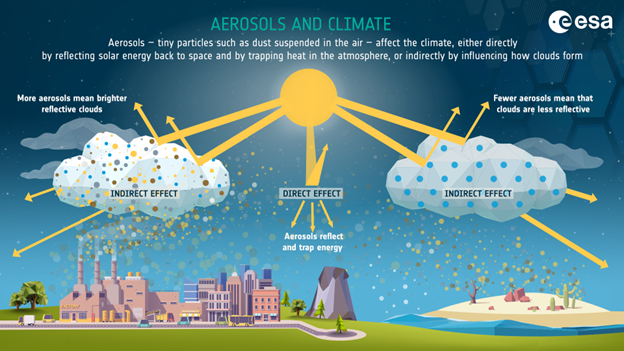Improving Aerosol Radiative Forcing and Climate in DOE’s E3SM
New cloud microphysics and improved wet removal treatments improve climate simulations.
The Science
Anthropogenic aerosols cool the Earth by reflecting solar radiation back into space and increasing cloud reflectivity (Fig. 1). This effect is divided into direct and indirect aerosol radiative forcings. They can effectively offset the warming effects of greenhouse gases. It plays a crucial role in simulating climate. Many Earth system models, including the U.S. Department of Energy’s Energy Exascale Earth System Model (E3SM), exhibit excessive aerosol effective forcing. This is primarily due to the challenges in accurately simulating aerosols, clouds, and their complex interactions. Researchers have improved aerosol and cloud treatments in E3SM version 3 (v3), which mitigates the aerosol and cloud biases and achieves more accurate aerosol radiative forcings.
The Impact
The overly strong aerosol forcing was a primary reason for former versions of E3SM (both version 1 and 2) to fail to simulate observed surface temperature trends over the industrial period. This casts doubt on its reliability in projecting future climate change. The researchers’ new developments in E3SM v3 significantly mitigate the aerosol and cloud biases, resulting in aerosol direct and indirect forcings that agree well with the Sixth Assessment Report of the Intergovernmental Panel on Climate Change (IPCC AR6). These developments play a major role in the reproduction of surface temperature trends over the industrial period by E3SM v3 (Fig. 2), an unattainable task in the previous E3SM versions. This is a game changer for increasing the fidelity of E3SM in climate projection.

Figure 2. The new cloud microphysics scheme P3 (red) decreases indirect aerosol forcing. The improved aerosol wet removal treatments (green) substantially reduce both direct and indirect aerosol forcing on the top of all cloud developments for v3 (blue), making both forcing values more realistic based on the IPCC reference ranges denoted by the two dash lines. Increasing the hygroscopicity of primary organic matters (kPOM; orange) further decreases indirect aerosol forcing, and qualitatively changing aerosol direct forcing from position to negative, making the model value sit well in the middle of the IPCC reference range.
Summary
Numerous Earth system models exhibit excessive aerosol effective forcing, including the U.S. Department of Energy’s Energy Exascale Earth System Model (E3SM). Here, in the context of the E3SM version 3 effort, the predicted particle property (P3) stratiform cloud microphysics scheme and an enhanced deep convection parameterization suite (ZM_plus) are implemented into E3SM. The ZM_plus includes a convective cloud microphysics scheme, a multi-scale coherent structure parameterization for mesoscale convective systems, and a revised cloud base mass flux formulation considering the impacts of the large-scale environment. The P3 scheme improved cloud and radiation, particularly over the Northern Hemisphere and the frequency of heavy precipitation over the tropics, and the ZM_plus improved clouds in the tropics. P3 decreases aerosol effective forcing by 0.15 W m−2, while the ZM_plus increases it by 0.27 W m−2, resulting from excessive direct (0.31 W m−2) and indirect forcing (−1.79 W m−2). The excessive aerosol forcings are due to aerosol overestimation associated with insufficient aerosol wet removal. By improving the physical treatments in the aerosol wet removal, researchers effectively mitigate anthropogenic aerosol overestimation and thus attenuate direct (0.09 W m−2) and indirect aerosol forcing (−1.52 W m−2). Adjustment to primary organic matter hygroscopicity reduces direct and indirect forcing to more reasonable values: −0.13 W m−2 and −1.31 W m−2, respectively.
Publication
- Shan, Yunpeng, Jiwen Fan, Kai Zhang, Jacob Shpund, Christopher Terai, Guang J. Zhang, Xiaoliang Song, et al. 2024. “Improving Aerosol Radiative Forcing And Climate In E3Sm: Impacts Of New Cloud Microphysics And Improved Wet Removal Treatments”. Journal Of Advances In Modeling Earth Systems 16 (8). American Geophysical Union (AGU). doi:10.1029/2023ms004059.
Funding
- This work was supported by the Earth System Model Development program area of the Department of Energy, Office of Science, Biological and Environmental Research program.
Contact
- Yunpeng Shan, Pacific Northwest National Laboratory
- Jiwen Fan, Argonne National Laboratory
This article is a part of the E3SM “Floating Points” Newsletter, to read the full Newsletter check:



